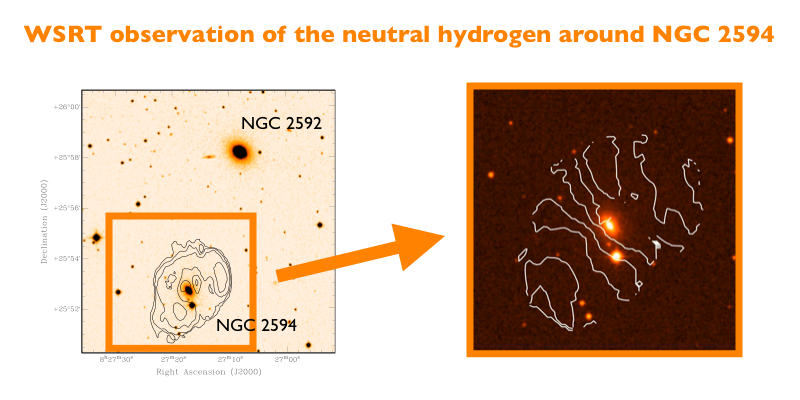Daily Image
28-03-2008A polar ring of neutral hydrogen around an Atlas3D galaxy
| Submitter: | Paolo Serra |
| Description: | The picture above shows the result of a 12-hour Westerbork observation of two galaxies belonging to the Atlas3D sample. Atlas3D is a project that will provide the largest multi-wavelength dataset to date for the study of nearby elliptical and lenticular galaxies. 265 galaxies closer than 40 Mpc are being observed from the ultraviolet to the millimiter region of the spectrum with imaging and spectroscopy. Researchers at ASTRON are making use of the WSRT to observe the neutral hydrogen gas (HI) around galaxies in the Atlas3D sample. The galaxies NGC 2592 and NGC 2594 could be observed with just one WSRT pointing. The figure on the left shows contours of constant surface density of the detected HI plotted on top of an optical image. Only NGC 2594 hosts some HI. The gaseous distribution is very interesting because it is perpendicular to the stellar structure. The former is elongated from south-east (bottom-left) to north-west (top-right); the latter from south-west (bottom-right) to north-east (top-left). The HI exhibits a central hole, so it is a polar ring around the host galaxy. On the right we show the velocity field of the HI. Each white line represents the HI gas at a given velocity along the line of sight. As on the left, the lines are plotted on top of an optical image. The figure shows the typical aspect of a regularly-rotating ring. The rotation confirms that the gas ring is perpendicular to the stellar component of the galaxy. Because the HI motion is not compatible with that of the stars, the origin of the HI is likely external. Steady accretion of cold gas from the medium surrounding the galaxy could explain the existence of such HI systems. |
| Copyright: | Atlas3D |
| Tweet |  |
